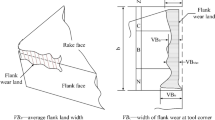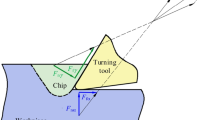Abstract
γ-TiAl alloy is an advanced material with a vast prospect of applications, but its processing is a well-known engineering problem. In this article, the optimum range of cutting parameters of cemented carbide tool has been obtained by several turning experiments. In fact, tool wear has a great effect on cutting force. These four major effects, flank wear width, cutting speed, cutting depth, and feed rate on turning force, have been carefully discussed. Meanwhile, the turning force model of γ-TiAl alloy has been established. This model studied both the cutting force on rake face and the wear effect force on flank face. Several key coefficients have been determined by fitting the extensive experimental results. Later, the accuracy has been examined. The experimental results show tool life is short and tool wear is intense in general. At the cutting speed of 50 m/min, when feed rate does not exceed 0.1 mm and cutting depth does not exceed 0.3 mm, tool life is relatively longer and surface quality is relatively better. Within this range, the cutting force is approximately linear with respect to the cutting depth and the feed rate. In addition, the cutting force will increase significantly with the increase of the flank wear width. It turns out the model has a higher accuracy and it can appropriately reflect the change of cutting force.













Similar content being viewed by others
References
Wang H, Zhou MX, Wu BH (2015) Advances in manufacturing technology of advanced materials and high performance components for aeroengine. Aviat Manuf Technol 22:47–51. https://doi.org/10.16080/j.issn1671-833x.2015.22.047
Yamaguchi M, Inui H, Ito K (2000) High-temperatures structural intermetallics. Acta Mater 48(1):307–322. https://doi.org/10.1016/s1359-6454(99)00301-8
Sauthoff G (2000) Multiphase intermetallic alloys for structural applications. Intermetallics 8(9-11):1101–1109. https://doi.org/10.1016/S0966-9795(00)00045-5
Cai JM, Mi GB, Gao F, Huang H (2016) Research and development of advanced high-temperature titanium alloy materials for aeroengine. Mater Eng 44(08):1–10. https://doi.org/10.11868/j.issn.1001-4381.2016.08.001
Wang DC (2012) Application status and development trend of titanium and aluminum alloy. China Airl News 007:1–2
Clemens H, Kestler H (2000) Processing and applications of intermetalic γ-TiAl-based alloys. Adv Eng Mater 2(9):551–570. https://doi.org/10.1002/1527-2648(200009)2:9<551::aid-adem551>3.0.co;2-u
Aspinwall DK, Dewes RC, Mantle AL (2005) The machining of γ-TiAl intermetallic alloys. CIRP Ann Manuf Technol 54(1):99–104. https://doi.org/10.1016/S0007-8506(07)60059-6
Yang R (2015) Progress and challenges of titanium and aluminum intermetallics. J Metals 51(02):129–147. https://doi.org/10.11900/0412.1961.2014.00396
Mantle AL, Aspinwall DK (1997) Surface integrity and fatigue life of turned γ-titanium aluminide. J Mater Process Technol 72(3):413–420. https://doi.org/10.1016/S0924-0136(97)00204-5
Hood R, Mantle AL, Aspinwall DK (2014) Workpiece surface integrity when slot milling γ-TiAl intermetallic alloy. CIRP Ann Manuf Technol 63(1):53–56. https://doi.org/10.1016/j.cirp.2014.03.071
Aspinwall DK, Mantle AL, Chan WK, Hood R, Soo SL (2013) Cutting temperatures when ball nose end milling γ-TiAl intermetallic alloys. CIRP Ann Manuf Technol 62(1):75–78. https://doi.org/10.1016/j.cirp.2013.03.007
Hood R, Aspinwall DK, Sage C, Voice W (2013) High speed ball nose end milling of γ-TiAl alloys. Intermetallics 32:284–291. https://doi.org/10.1016/j.intermet.2012.09.011
Beranoagirre A, Olvera D, Lopez de Lacalle LN (2012) Milling of γ-titanium aluminium alloys. Int J Adv Manuf Technol 62(1–4):83–88. https://doi.org/10.1007/s00170-011-3812-6
Lin B, Wang L, Guo Y, Yao JM (2016) Modeling of cutting forces in end milling based on oblique cutting analysis. Int J Adv Manuf Technol 84:727–736. https://doi.org/10.1007/s00170-015-7724-8
Koenigsberger F, Sabberwal AJP (1961) An investigation into the cutting force pulsations during milling operations. Int J Mach Tool Des Res 1(1-2):15–33. https://doi.org/10.1016/0020-7357(61)90041-5
Li ZL, Ding Y, Zhu LM (2017) Accurate cutting force prediction of helical milling operations considering the cutter runout effect. Int J Adv Manuf Technol 92:4133–4144. https://doi.org/10.1007/s00170-017-0464-1
Bhattacharyya A, Schueller JK, Mann BP, Ziegert JC (2010) A closed form mechanistic cutting force model for helical peripheral milling of ductile metallic alloys. Int J Mach Tools Manuf 50(6):538–551. https://doi.org/10.1016/j.ijmachtools.2010.03.003
Wei ZC, Guo ML, Wang MJ, Li SQ, Liu SX (2018) Prediction of cutting force in five-axis flat-end milling. Int J Adv Manuf Technol 96:137–152 https://link.springer.com/article/10.1007%2Fs00170-017-1380-0
Liu XW, Cheng K, Webb D, Luo XC (2004) Improved dynamic cutting force model in peripheral milling. Part II: experimental verification and prediction. Int J Adv Manuf 24(11-12):794–805. https://doi.org/10.1007/s00170-003-1797-5
Wou SJ, Shin YC, El-Mounayri H (2013) Ball end milling mechanistic model based on a voxel-based geometric representation and a ray casting technique. J Manuf Process 15(3):338–347. https://doi.org/10.1016/j.jmapro.2012.12.003
Yucesan G, Altintas Y (1994) Improved modelling of cutting force coefficients in peripheral milling. Int J Mach Tools Manuf 34:473–487. https://doi.org/10.1016/0890-6955(94)90079-5
Hou YF, Zhang DH, Wu BH, Luo M (2015) Milling force modeling of worn tool and tool flank wear recognition in end milling. IEEE/ASME Trans Mechatron 20(3):1024–1035. https://doi.org/10.1109/tmech.2014.2363166
Liu JH (2009) Modeling and simulation of cutting force. Xi’an University of Technology. http://kns.cnki.net/kns/detail/detail.aspx?FileName=2010139436.nh&DbName=CMFD2011
Lapsley JT, Grassi RC, Thomsen EG (1950) Correlation of plastic deformation during metal cutting with tensile properties of the work material. Trans ASME 72:979–986
Waldorf DJ (1996) Shearing, ploughing and wear in orthogonal machining. Champaign: University of Illinois at Urbana-Champaign. http://hdl.handle.net/2142/22648
Kapoor SG, De Vor RE, Zhu R, Gajjela R, Parakkal G, Smithey D (1998) Development of mechanistic models for the prediction of machining performance: model-building methodology. Int J Mach Sci Technol 2(2):215–238. https://doi.org/10.1080/10940349808945669
Waldorf DJ, Kapoor SG, De Vor RE (1999) Worn tool forces based on ploughing stresses. Trans North Am Manuf Res Inst SME 27:165–170
Smithey DW, Kapoor SG, De Vor RE (2001) A new mechanistic model for predicting worn tool cutting forces. Mach Sci Technol 5(1):23–42. https://doi.org/10.1081/MST-100103176
Funding
The work is supported by the National Natural Science Foundation of China (51775280).
Author information
Authors and Affiliations
Corresponding authors
Additional information
Publisher’s note
Springer Nature remains neutral with regard to jurisdictional claims in published maps and institutional affiliations.
Rights and permissions
About this article
Cite this article
Cheng, Y., Yuan, Q., Zhang, B. et al. Study on turning force of γ-TiAl alloy. Int J Adv Manuf Technol 105, 2393–2402 (2019). https://doi.org/10.1007/s00170-019-04356-z
Received:
Accepted:
Published:
Issue Date:
DOI: https://doi.org/10.1007/s00170-019-04356-z




